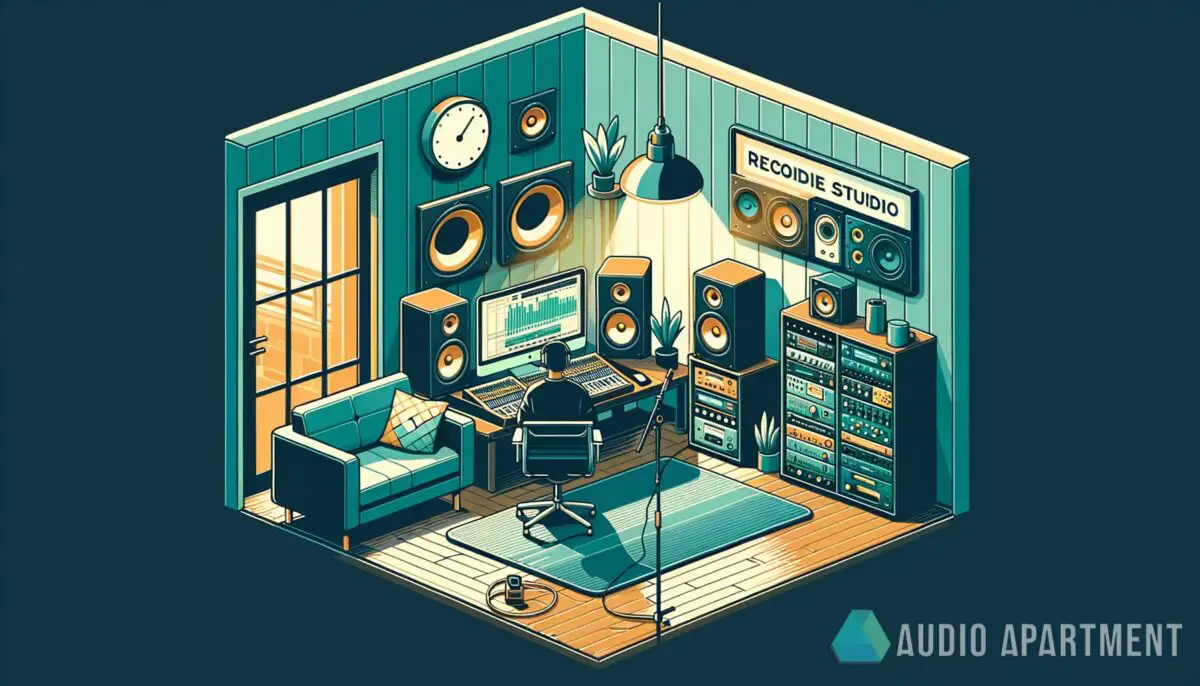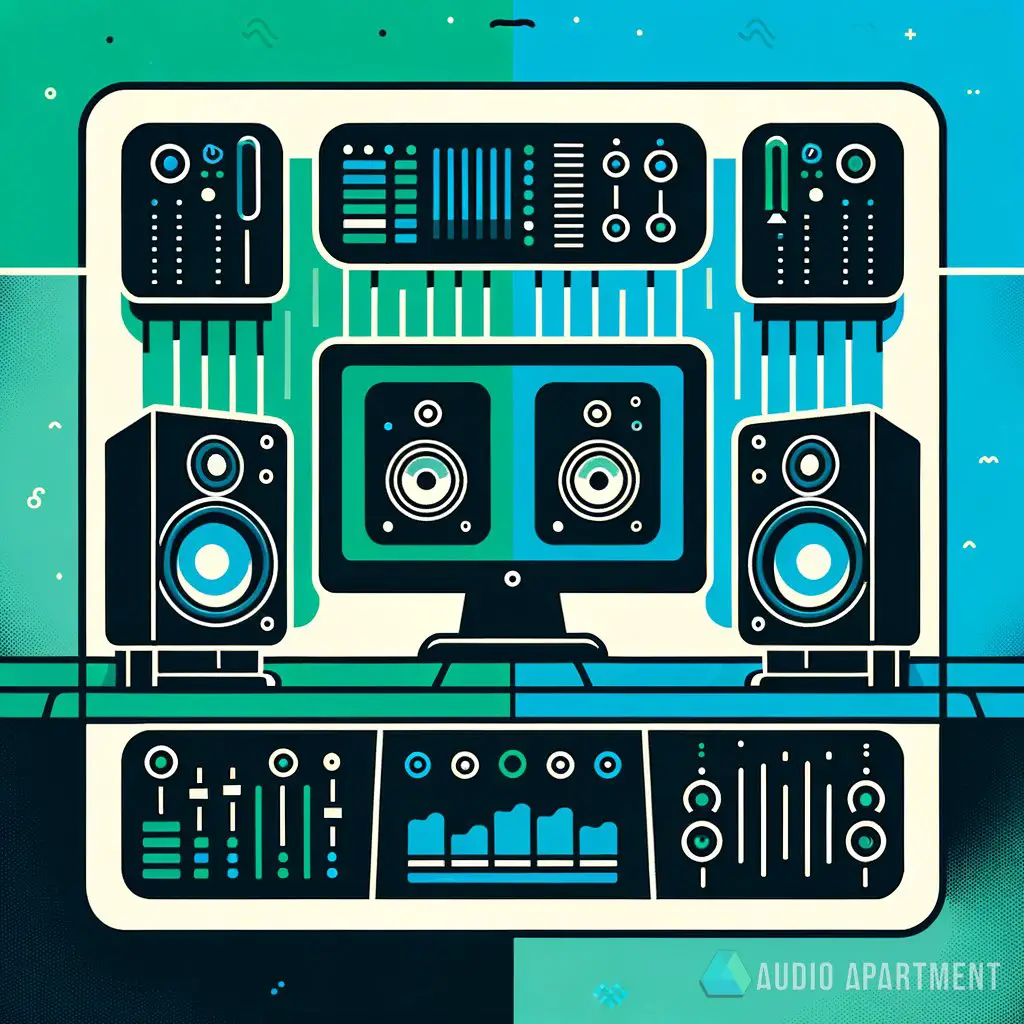Ever found yourself in the middle of a heated debate about whether studio monitors or headphones are crucial for sound clarity? Well, it’s a common battle in forums and studios worldwide.
Choosing the right audio gear can profoundly influence your music production experience. Which is better for precise sound reproduction? This post dives into the nuances of studio monitors tailored to different music genres.
If you are a visual learner, check out this video titled ‘TOP 5: Best Studio Monitor 2022’
Key takeaways
- Match your monitor size to your room and acoustics.
- Look for a wide frequency range to cover the lows and highs of your music genre.
- Factor in room treatment costs, as good acoustics are crucial for accurate sound reproduction.
- Select monitors that complement your creative process and workflow.
What studio monitors will elevate your sound game?
When it comes to producing music that not only slaps but also resonates perfectly within your genre, choosing the right studio monitor is everything. It’s like selecting the right spice for your culinary masterpiece – the choice can elevate your creation to levels that blow minds.

Accurate sound reproduction across the frequency spectrum is crucial for crafting those bangers. So, let’s dive into the studio monitors that promise to deliver precision for your genre.
1. The genre-defining choice
For those immersed in the world of classic rock and 90s alternative, the quest for studio monitors that bring out the raw energy and authenticity of guitars and drums is real. Monitors designed with a flat frequency response ensure every strum and beat is reproduced faithfully, without any coloration.
This fidelity is crucial for making mix decisions that stay true to the genre’s roots. For artists working in these genres, considering monitors that specialize in midrange clarity can be a game-changer, delivering that sought-after crisp and detailed sound.
Check out some top recommendations here.
2. The hip-hop heavyweight
Hip-hop production leans heavily into deep bass and crisp highs to get that head-bobbing, soul-grabbing effect. Monitors that can handle the extreme dynamic range of hip-hop, from 808 kicks to snare snaps, without distortion, are key.

A studio monitor that offers a deep bass response and clear, detailed highs can make the difference, allowing producers to nail that mix’s punch and clarity. Understanding audio compression can further enhance your hip-hop production, ensuring your tracks hit just right.
3. The all-rounder for digital lovers
Those who dip their creativity into a bit of everything, especially digital music genres embracing MIDI and virtual instruments, need a studio monitor that’s as versatile as they are. A monitor that delivers a consistent and flat response across the frequency spectrum allows for accurate mixing, ensuring tracks sound great on any system.
By embracing monitors with a wide sweet spot, producers can enjoy flexibility in their studio setup, encouraging experimentation and creativity. Dive into the essentials of MIDI controllers to boost your production skills.

4. The acoustic artisan’s choice
For those whose heart lies with acoustic genres, monitors that excel in revealing the natural tones and subtleties of acoustic instruments are invaluable. The ability to accurately reproduce the warmth and richness of acoustic sounds makes a huge difference in the mixing process, ensuring the authentic expression of the music.
Monitors that offer exceptional detail in the mid to high frequencies shine in this area, capturing the essence of acoustic music. Learn more about capturing studio-quality vocals and acoustic instruments.
5. The electronic music maestro
Crafting floor-filling electronic bangers demands monitors that can deliver the pulsating lows and sparkling highs inherent to the genre. Look for monitors with a robust low-end response that can keep up with bass-heavy mixes without muddying the midrange.
Choosing the right studio monitors is more than just picking a price point or brand—it’s about understanding what will best serve your music and workflow. Accurate sound reproduction across the frequency spectrum is crucial for crafting those bangers that resonate perfectly within your genre.
This ensures the kicks punch through and the basslines groove as intended. A monitor with detailed high-frequency reproduction can illuminate the intricacies of synthesized melodies, leading to a mix that translates well across various listening environments.
Check out how achieving a balanced stereo image can refine your electronic mixes.
AKAI Professional MPK Mini MK3

AKAI Professional MPK Mini MK3
More studio monitor selection tips
Choosing the right studio monitors is more than just picking a price point or brand—it’s about understanding what will best serve your music and workflow. To nail down the perfect choice, you also need to consider the nuances of your studio space, listening habits, and end goals.
Here are some pointers to keep in mind:
- Room size and acoustics: Match your monitor size to your room. Smaller rooms might not handle the bass response of larger monitors well.
- Listening distance: Consider how far you’ll be from the monitors. Near-field monitors are ideal for close listening environments.
- Connectivity options: Ensure the monitors have the right inputs (XLR, TRS, etc.) to connect seamlessly with your existing setup.
- Frequency range: Look for monitors that offer a wide frequency range to cover the lows and highs of your music genre.
- Budget: Don’t forget to factor in room treatment costs, as good acoustics play a vital role in accurate sound reproduction.
In the realm of studio monitor selection, a few dos and don’ts can make a huge difference:
| Do | Don’t |
|---|---|
| Test the monitors in your own space if possible | Rely solely on reviews and specs |
| Consider monitor stands for optimal positioning | Forget about room acoustics |
| Explore options with adjustable EQ settings | Compromise on quality due to budget constraints |
| Listen to familiar tracks to evaluate performance | Make a rushed decision |
Choosing monitors isn’t just about the specs; it’s about how they fit into your unique music-making process.
Advantages and disadvantages of choosing studio monitors
Deciding on the right studio monitors is a critical step in music production, one that can significantly impact the final output of your work. The right monitors can bring clarity, depth, and precision to your mixes, allowing you to make informed decisions about balance, panning, EQ, and more.
Advantages
- Accurate sound reproduction allows for precise mixing decisions.
- Better translation of your mix across various listening systems.
- Detailed sonic clarity helps identify and correct issues in the mix.
- Enables critical listening for frequencies, dynamics, and stereo imaging.
- Improves the overall quality of your production by allowing for meticulously balanced mixes.
Disadvantages
- Can be expensive, especially higher-end models designed for professional studios.
- Requires a properly treated room to fully benefit from their accuracy.
- May lead to analysis paralysis, where too much focus on detail can overwhelm the mixing process.
- Not portable, limiting mixing work to the studio.
- Can have a steep learning curve for beginners not used to flat frequency responses.
Opinion
As someone who’s just dipping their toes into the vast ocean of music production, the task of choosing the right studio monitors can feel daunting. From my non-expert perspective, it seems like balancing budget, room acoustics, and music genre needs is more art than science.
Reading up on how artists in similar genres make their choices has been insightful. Particularly, understanding the importance of mid-range clarity for rock or the depth of bass for hip-hop adds layers to this decision.
For those curious, exploring more about how to create realistic virtual instrument performances might provide more context to how studio monitors can influence the outcome of your music production.
In my opinion, the pursuit of the perfect studio monitor setup is a journey rather than a destination. Given the personal and subjective nature of music production, what works for one might not for another.
Yet, the endeavor to understand and select studio monitors that elevate your sound is undoubtedly a step toward honing your craft. Embracing this process, with its trials and errors, seems not only necessary but enriching to the creative experience.
Frequently asked questions (FAQ)
How important is room size when choosing studio monitors?
Room size significantly influences the type and size of studio monitors you should consider. Larger monitors might overpower a small room, causing inaccuracies in bass frequencies due to sound reflections.
Conversely, small monitors in a very large room might not provide enough power to accurately gauge your mix. It’s all about finding a balance that complements your workspace.
Can I mix with just headphones instead of studio monitors?
While headphones can be a great tool for detailed listening and identifying specific issues in a mix, they don’t offer the same spatial representation as studio monitors. Mixing primarily with headphones might lead to mixes that sound good on headphones but don’t translate well to other playback systems.
It’s generally recommended to use both in conjunction to achieve a balanced mix.
Do I need a subwoofer with my studio monitors?
A subwoofer can be a valuable addition to your studio setup, especially if your main monitors lack the capability to accurately reproduce lower frequencies. This is particularly true for genres like hip-hop or electronic music that rely heavily on bass.
However, adding a subwoofer requires careful setup and calibration to ensure it enhances rather than muddies your mix.
Final thoughts
Navigating the world of studio monitors can initially seem like a maze, but understanding the nuances and what makes each type tick with different genres of music demystifies the process. Whether you’re crafting beats in your bedroom or mixing down tracks in a home studio, the right monitors can elevate your music, ensuring what you create hits as intended, regardless of where it’s played.
Remember, every decision in music production is a step towards refining your signature sound and mastering your craft.
What studio monitors have you found work best for your music production needs? Did I cover everything you wanted to know? Let me know in the comments section below I read and reply to every comment. If you found this article helpful, share it with a friend, and check out my full blog for more tips and tricks on choosing the best studio monitors.
Thanks for reading and keep honing your sound.















